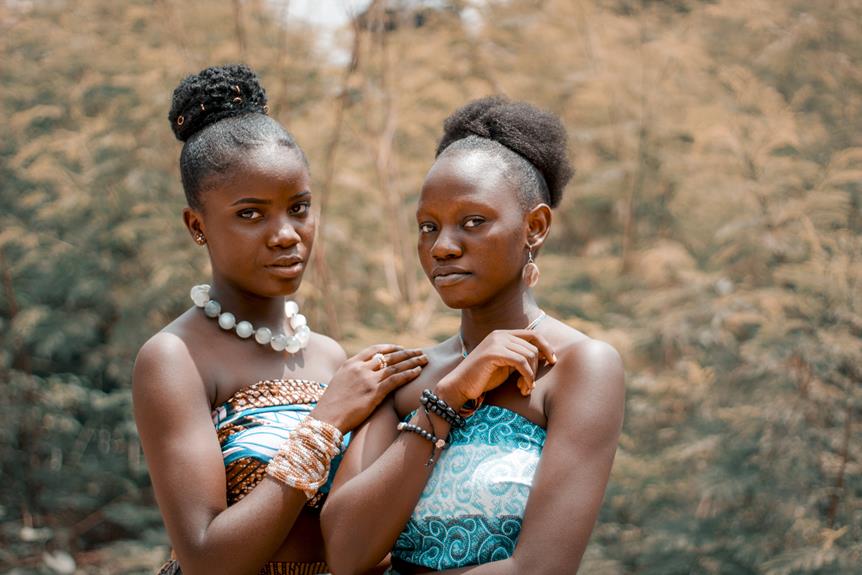What Is Woman Circumcision and Its Cultural Context

While the practice of woman circumcision, also known as female genital mutilation, has sparked international debate and condemnation, it is essential to understand its cultural context to address this issue effectively.
This article aims to provide an in-depth exploration of the historical origins, cultural significance, regional variations, societal perceptions, and legal debates surrounding woman circumcision.
By delving into these aspects, we can gain a comprehensive understanding of this complex issue and work towards eradicating it through education and empathy.
Key Takeaways
- Woman circumcision has a long historical evolution and is prevalent in certain regions, particularly in parts of Africa, the Middle East, and Southeast Asia.
- Woman circumcision often serves as a rite of passage symbolizing cultural identity and the transition from girlhood to womanhood, raising questions about gender roles, personal autonomy, and ethical implications.
- Cultural preservation involves safeguarding and protecting traditional practices and beliefs, with intergenerational transmission ensuring the continuity of cultural traditions.
- Female genital mutilation (FGM) raises concerns about health consequences and ethical considerations, violating human rights and bodily autonomy, while being deeply rooted in cultural beliefs and traditions.
Historical Origins and Practices
The historical origins and practices of woman circumcision have been extensively studied by anthropologists to understand the cultural context in which it occurs. This practice has a long historical evolution, dating back thousands of years in various parts of the world.
It is important to note that woman circumcision is not a universally practiced tradition, but it is prevalent in certain regions. The global prevalence of this practice varies, with estimates suggesting that it is most common in parts of Africa, the Middle East, and Southeast Asia.
However, it is crucial to approach this topic with sensitivity and respect for cultural differences. Understanding the historical evolution and global prevalence of woman circumcision can contribute to a more comprehensive understanding of its cultural context and inform efforts towards promoting dialogue, education, and respectful engagement.
Cultural Significance and Beliefs
Cultural significance and beliefs surrounding woman circumcision are complex and varied, reflecting the traditions and values of different communities. These practices often serve as a rite of passage, symbolizing cultural identity and the transition from girlhood to womanhood.
However, they also raise important questions about gender roles, personal autonomy, and the ethical implications of such procedures.
Cultural Traditions and Practices
Within the context of cultural traditions and practices, exploring the significance and beliefs surrounding certain rituals becomes imperative for a comprehensive understanding of a society. Cultural preservation and intergenerational transmission play crucial roles in upholding these traditions.
By passing down rituals and practices from one generation to the next, communities ensure the continuity of their cultural heritage. Cultural preservation involves the conscious effort to safeguard and protect traditional practices and beliefs, recognizing their value in shaping the identity and cohesion of a society.
Through intergenerational transmission, knowledge and understanding of these rituals are transferred, allowing younger members of the community to learn and participate in their cultural heritage. Understanding the significance and beliefs behind these rituals promotes respect and appreciation for diverse cultural practices.
It allows individuals to grasp the importance of cultural preservation and intergenerational transmission, fostering a sense of unity and inclusivity within a society. By recognizing and celebrating cultural traditions and practices, we can embrace the richness and diversity of the world we live in, serving others by promoting cultural understanding and acceptance.
Gender Roles and Identity
Examining the cultural significance and beliefs surrounding gender roles and identity reveals the intricate complexities and societal expectations placed upon individuals. In many cultures, gender roles are deeply ingrained in traditional practices and beliefs, shaping the way individuals perceive themselves and their place in society. Here are some key points to consider:
- Gender roles are often defined by cultural traditions and expectations, which can vary greatly across different societies.
- These roles can encompass a wide range of behaviors, responsibilities, and social norms that are specific to each gender.
- Gender identity is a deeply personal and subjective experience that may or may not align with societal expectations.
- Cultural traditions play a significant role in shaping and perpetuating gender roles, often reinforcing traditional gender binaries and stereotypes.
- Challenging and redefining these roles can be a complex and sensitive process, requiring a shift in societal attitudes and beliefs.
Understanding the complexities of gender roles and identity is crucial for promoting inclusivity and creating a society that values and respects the diversity of individuals' experiences and identities.
Health and Ethical Implications
Understanding the health and ethical implications of cultural beliefs surrounding gender roles and identity is crucial for fostering a society that respects and supports individuals' well-being. One specific cultural practice that raises significant concerns in terms of health consequences and ethical considerations is female genital mutilation (FGM). FGM, also known as female circumcision, is a practice that involves the partial or total removal of the external female genitalia for non-medical reasons. This practice is deeply rooted in cultural beliefs and traditions in certain communities, often associated with notions of purity, modesty, and social acceptance. However, FGM can have severe physical and psychological health consequences for the individuals who undergo the procedure. It is essential to promote cultural acceptance while also advocating for the elimination of harmful practices that compromise the well-being and rights of individuals.
| Health Consequences | Ethical Considerations | Cultural Acceptance |
|---|---|---|
| Physical pain and trauma | Violation of human rights and bodily autonomy | Deeply ingrained cultural practice |
| Increased risk of infection | Perpetuates gender inequality | Believed to preserve social honor |
| Sexual complications | Lack of informed consent | Resistance to change due to cultural identity |
| Psychological trauma | Interferes with reproductive health | Fear of social exclusion |
| Long-term physical complications | Discrimination and stigmatization | Preservation of cultural heritage |
Regional Variations and Practices
One interesting aspect to consider regarding regional variations and practices is how they can shape cultural norms and traditions. Regional variations can greatly influence the way people live their lives and the values they hold. Traditional rituals, in particular, play a significant role in maintaining and preserving cultural identities.
Some examples of regional variations and practices include:
- Indigenous communities in South America who practice Ayahuasca ceremonies for spiritual healing and self-discovery.
- The Japanese tea ceremony, where the preparation and presentation of matcha tea is considered a form of art and meditation.
- The Indian festival of Holi, where people come together to celebrate the arrival of spring by throwing colored powders at each other.
- The Maasai tribe in East Africa, known for their elaborate beadwork and vibrant clothing, which symbolizes their cultural heritage and social status.
- The Mexican Day of the Dead, a celebration that honors and remembers deceased loved ones through colorful altars and offerings.
These regional variations and practices not only showcase the diversity of cultures but also have a profound impact on societal perceptions and impacts.
Societal Perceptions and Impacts
Highlighting the various regional variations and practices underscores the significant societal perceptions and impacts they have on cultural identities and norms.
One such topic that evokes strong societal attitudes and psychological effects is woman circumcision, also known as female genital mutilation (FGM). FGM is a cultural practice that involves the partial or complete removal of the external genitalia of young girls and women. It is prevalent in several regions around the world, predominantly in Africa, the Middle East, and Southeast Asia.
Societal attitudes towards FGM vary, with some communities considering it a rite of passage or a way to preserve cultural traditions, while others condemn it as a violation of human rights and a form of gender-based violence.
The psychological effects of FGM on women who undergo the practice can be profound and long-lasting, including physical pain, trauma, and complications during childbirth. Understanding and addressing these societal perceptions and impacts are crucial in promoting cultural sensitivity and advocating for the rights and well-being of women affected by FGM.
Legal and Ethical Debates
Legal and ethical debates surrounding woman circumcision are complex and multifaceted.
One point of contention is cultural relativism and the question of whether it should outweigh the potential harm inflicted on individuals.
Another important consideration is the human rights implications of this practice, as it directly impacts the physical and mental well-being of women.
Additionally, consent and bodily autonomy play a crucial role in these debates, as they raise questions about the rights of individuals to make decisions about their own bodies.
Cultural Relativism and Harm
The ongoing debate surrounding cultural relativism and harm centers on assessing the ethical implications and potential negative consequences of cultural practices.
Cultural relativism is the belief that all cultural practices should be respected and preserved, regardless of whether they align with universal human rights standards. However, this perspective raises important questions about the potential harm caused by certain cultural practices, such as female genital mutilation, child marriage, or honor killings.
These practices can have severe physical, emotional, and psychological consequences for individuals involved. The discussion surrounding cultural relativism and harm highlights the tension between the desire to preserve cultural traditions and the need to protect human rights and ensure the well-being of individuals.
It raises important ethical considerations about the balance between cultural preservation and the prevention of harm.
Human Rights Implications
One of the key ethical debates surrounding human rights implications is whether cultural practices that violate universal standards should be protected and preserved. This debate arises when considering the issue of human rights violations in the context of cultural preservation.
On one hand, cultural practices that harm individuals, such as female genital mutilation or child marriage, clearly violate universal human rights standards and should not be protected. These practices cause physical and psychological harm and perpetuate gender inequality.
On the other hand, some argue that cultural practices should be respected and preserved, as they are integral to a community's identity and heritage. However, when these practices violate the fundamental rights and dignity of individuals, it becomes essential to prioritize human rights over cultural preservation.
Striking a balance between cultural preservation and protecting individuals from human rights violations is a complex and ongoing discussion.
Consent and Bodily Autonomy
The ongoing discussion surrounding consent and bodily autonomy centers around the ethical debates on when individuals should have the right to make decisions about their own bodies and the importance of ensuring their autonomy is respected and protected.
Informed consent plays a crucial role in this discussion, highlighting the need for individuals to have access to accurate and comprehensive information before making decisions about their bodies.
Cultural sensitivity is also a key aspect, as different cultures may have varying beliefs and practices regarding bodily autonomy.
It is important to approach these discussions with respect and understanding, recognizing the diversity of perspectives and striving for dialogue that promotes mutual understanding and respect.
Efforts Towards Eradication and Education
Efforts towards eradication and education on the topic of woman circumcision have gained significant momentum in recent years.
Various organizations and individuals are actively working towards putting an end to this harmful practice and promoting awareness about its consequences.
Eradication efforts focus on advocating for legal reforms to ban the practice, as well as providing support and resources to affected communities.
Educational initiatives play a crucial role in raising awareness about the physical and psychological health risks associated with woman circumcision.
By providing accurate information and promoting open dialogue, these initiatives aim to change cultural norms and attitudes towards the practice.
Additionally, they seek to empower women and girls with knowledge and tools to protect their own rights and make informed decisions about their bodies.
Through these combined efforts, progress is being made towards ending woman circumcision and ensuring the well-being of women and girls worldwide.
Frequently Asked Questions
What Are the Health Risks Associated With Female Circumcision?
Female circumcision, also known as female genital mutilation/cutting, poses significant health risks. These include pain, infection, hemorrhage, urinary problems, and complications during childbirth. It is essential to address these health consequences while respecting the cultural significance of the practice.
How Does Female Circumcision Impact a Woman's Sexual Pleasure and Reproductive Health?
Female circumcision can have significant negative impacts on a woman's sexual pleasure and reproductive health, including physical and psychological consequences such as sexual trauma. However, it is important to recognize that cultural preservation plays a role in the practice.
What Are Some Common Misconceptions About Female Circumcision?
Common misconceptions about female circumcision stem from a lack of understanding of its cultural significance and historical perspectives. By exploring these aspects, we can dispel misunderstandings and approach the topic with empathy and respect.
How Does Female Circumcision Affect Gender Equality and Women's Rights?
Female circumcision affects gender equality and women's rights by perpetuating harmful cultural practices that reinforce gender inequality. It is important to address these issues and promote education and awareness to combat this violation of human rights.
What Are the Psychological and Emotional Effects Experienced by Women Who Have Undergone Female Circumcision?
The psychological and emotional effects experienced by women who have undergone female circumcision can include severe trauma, such as anxiety, depression, and post-traumatic stress disorder. These effects are deeply rooted in the cultural implications surrounding the practice.









